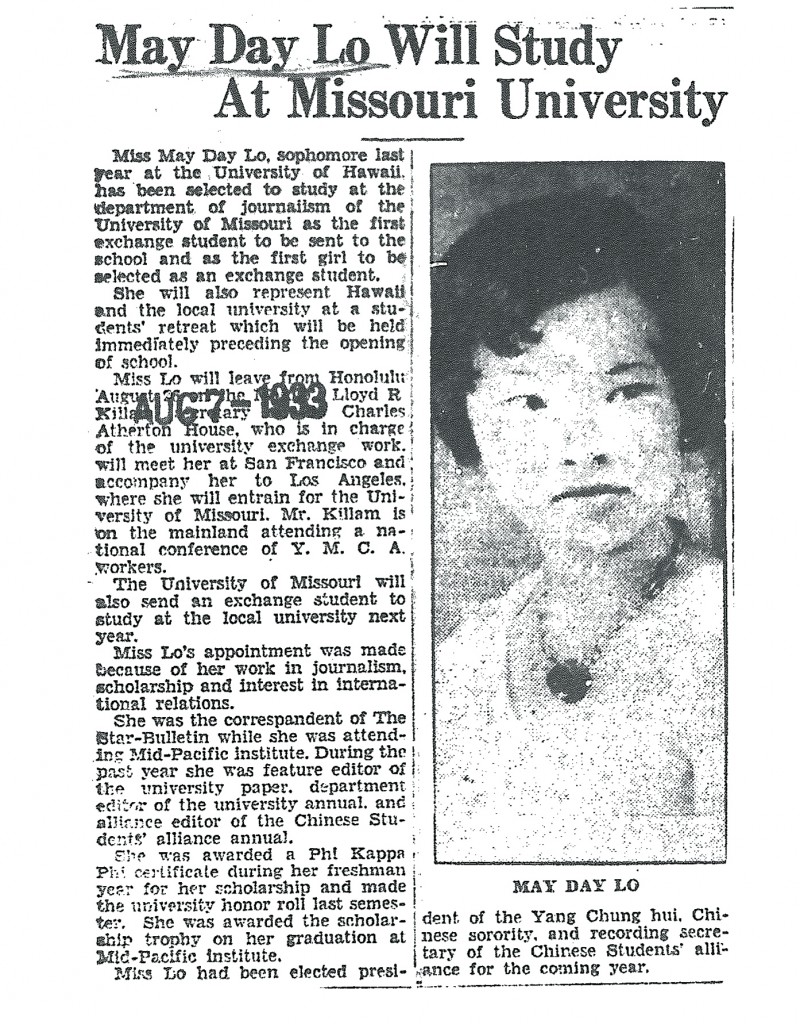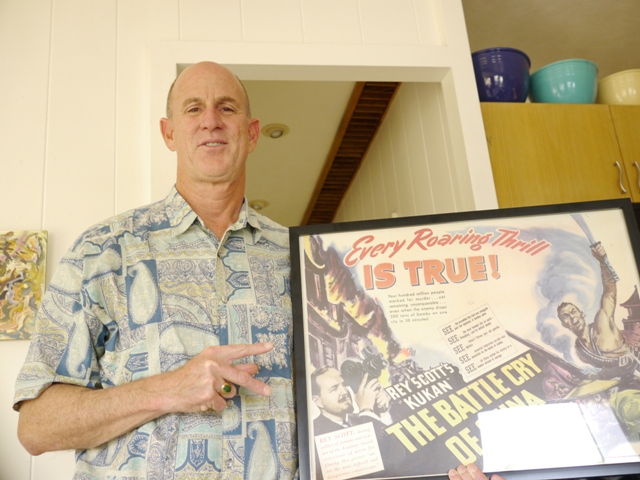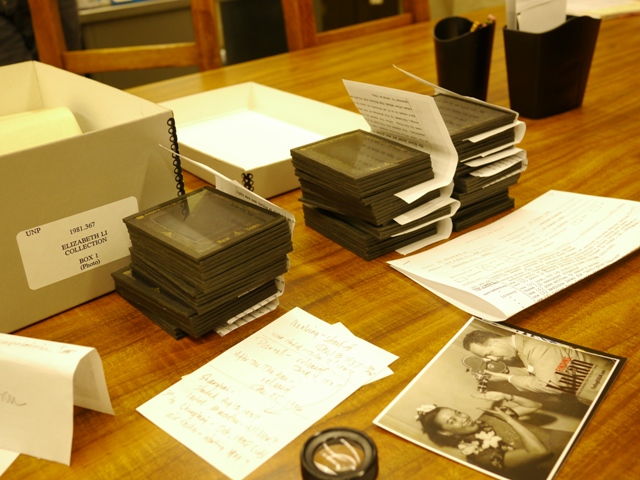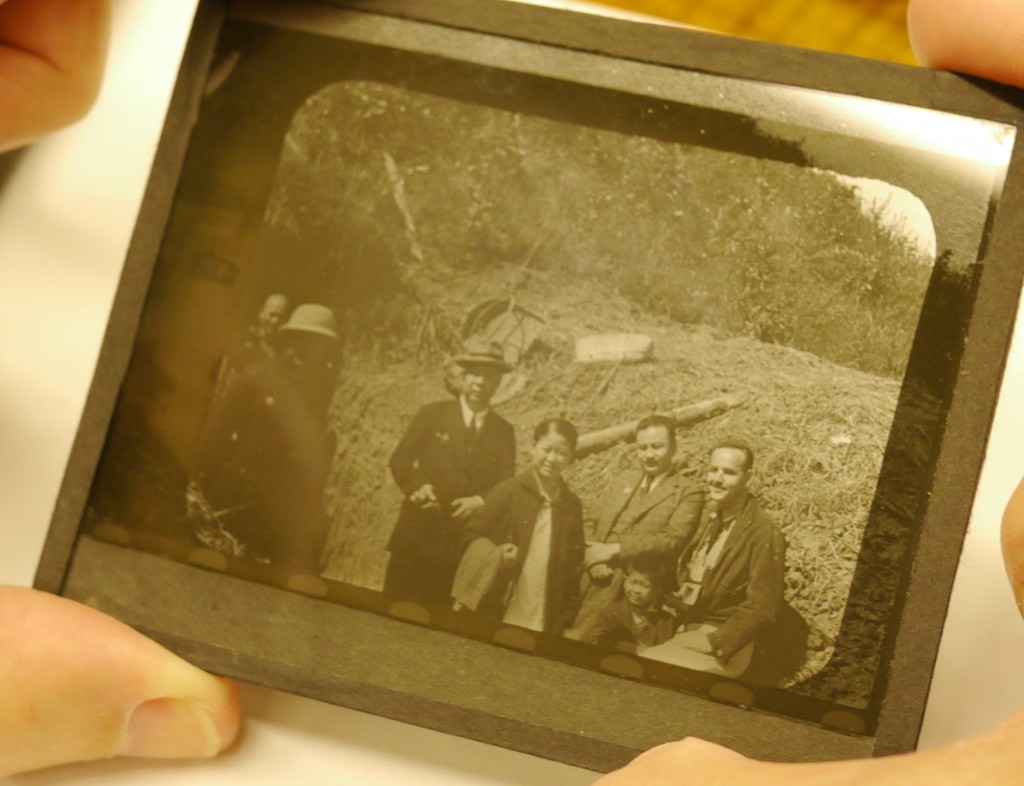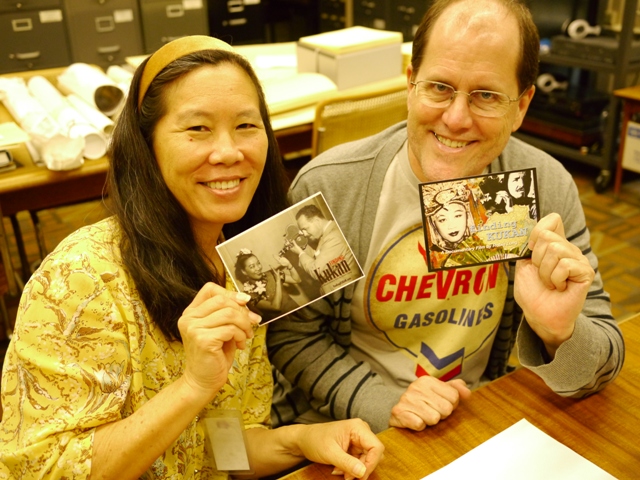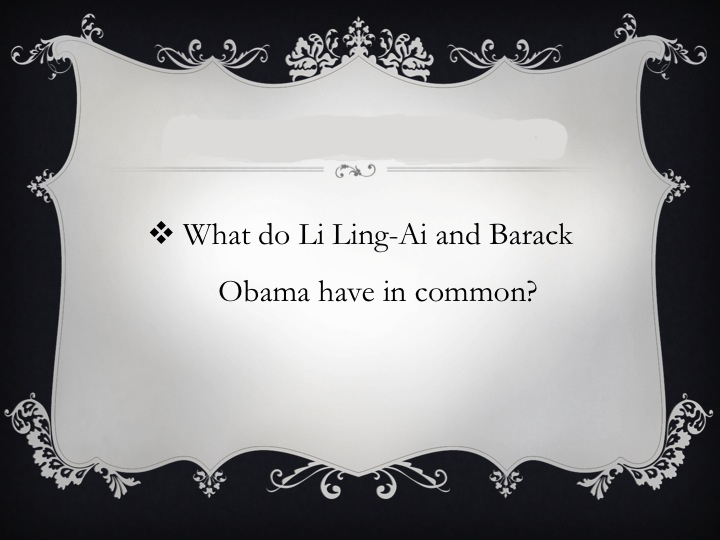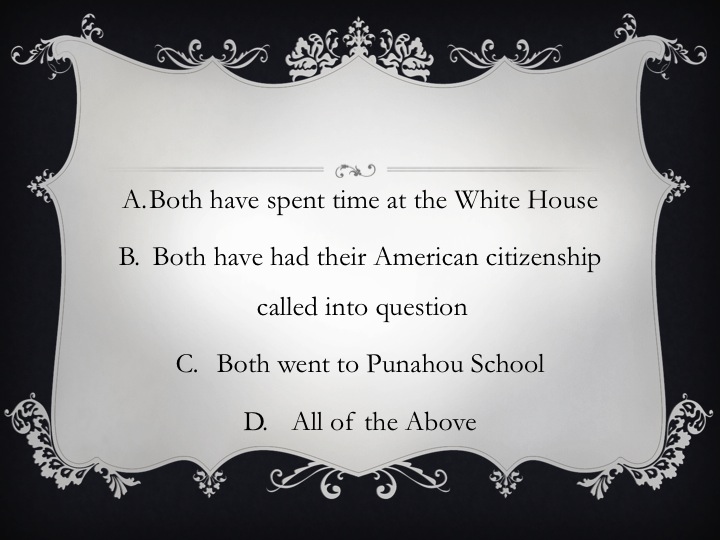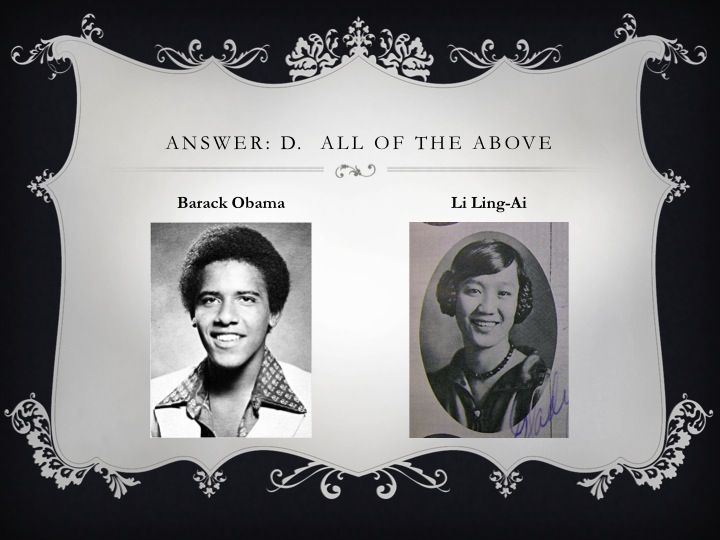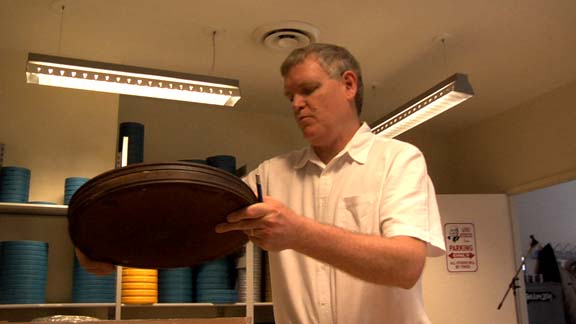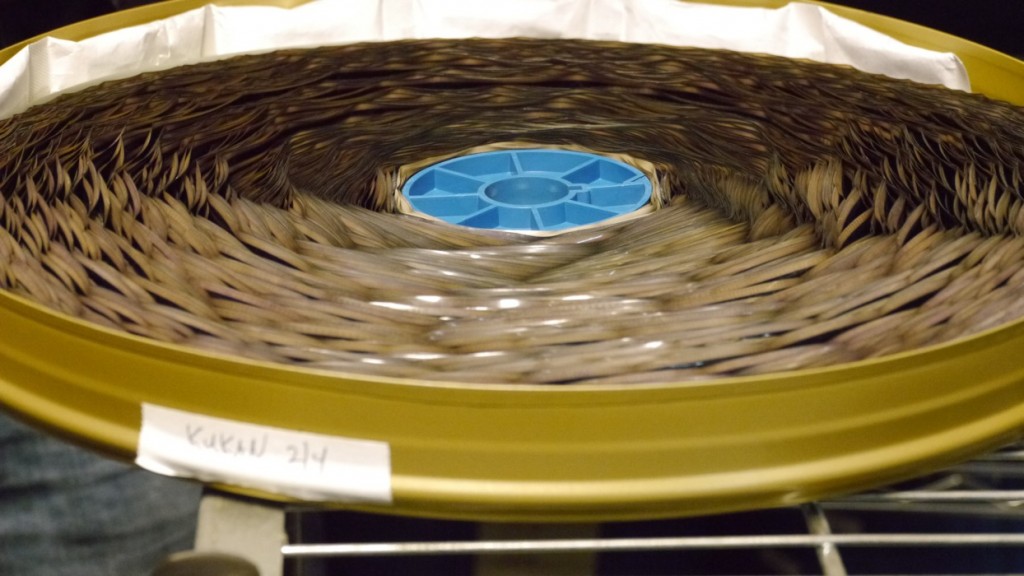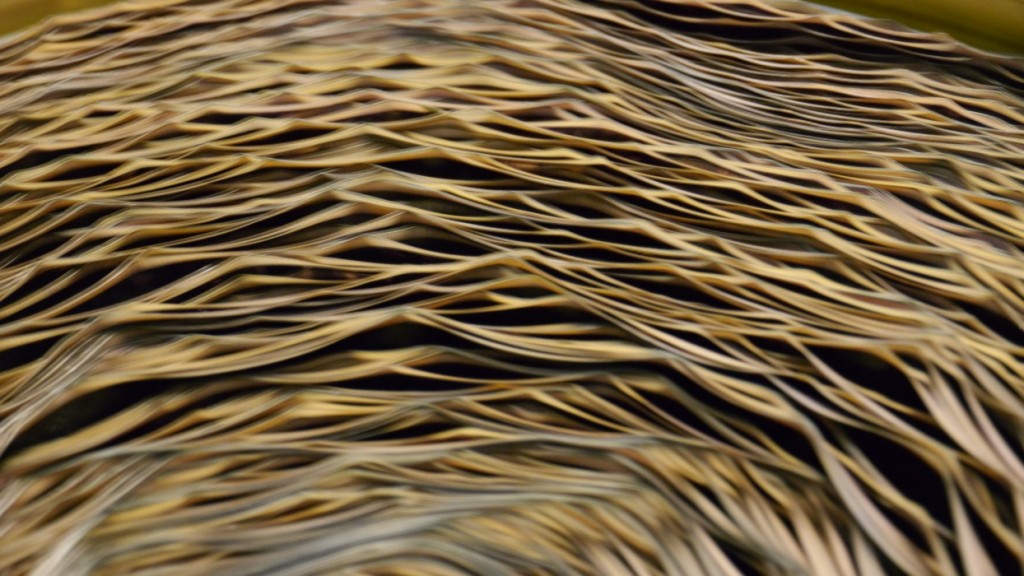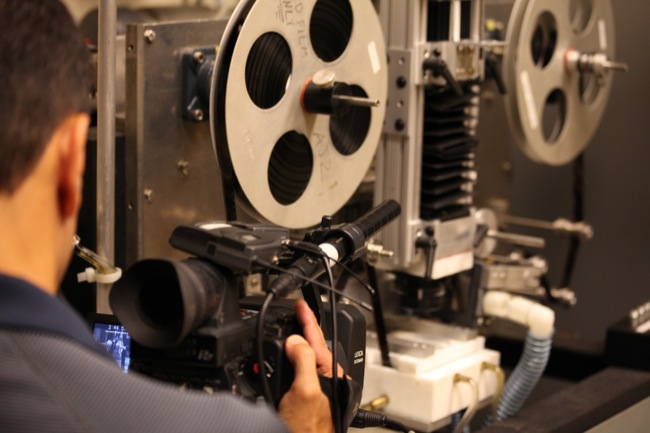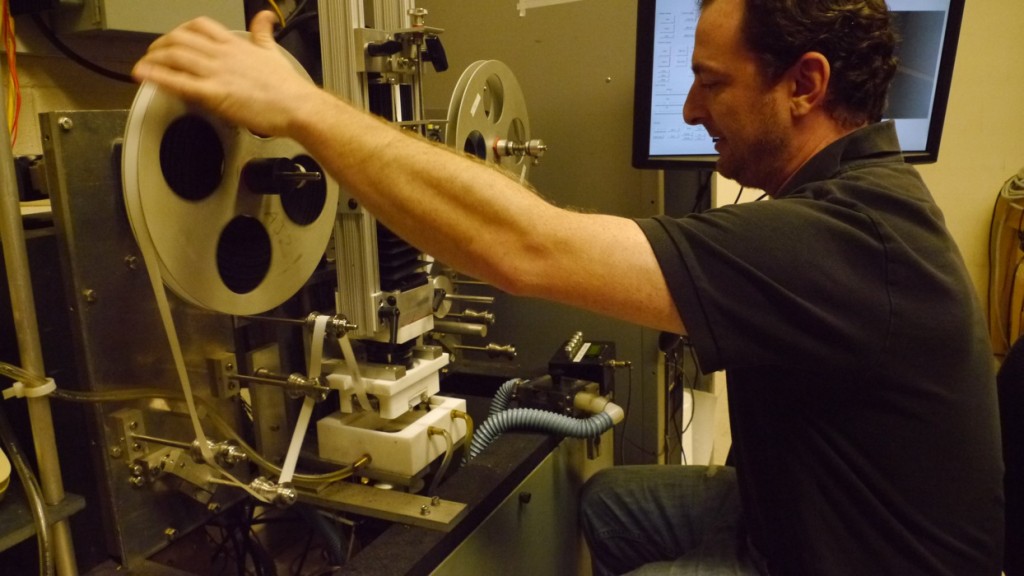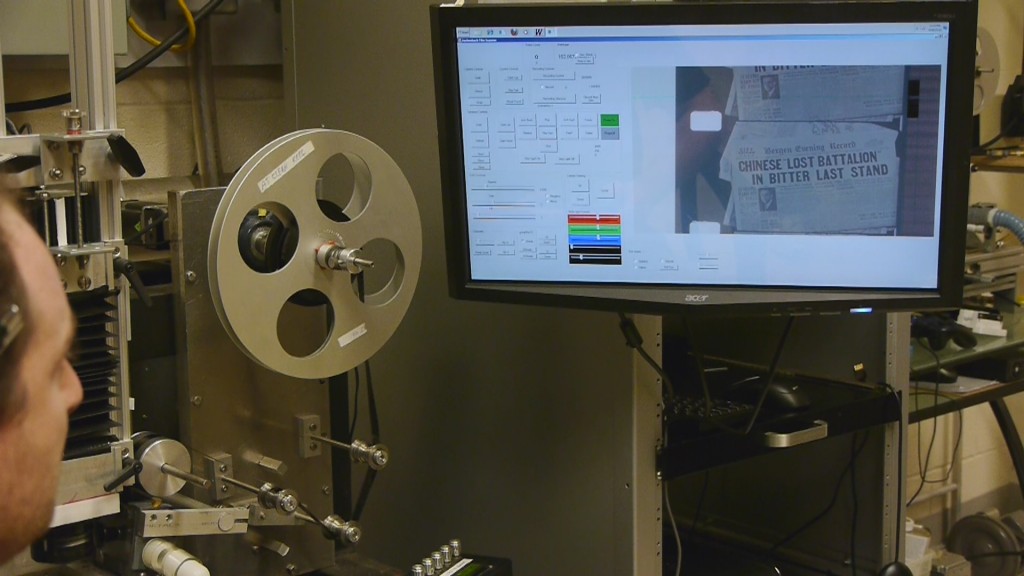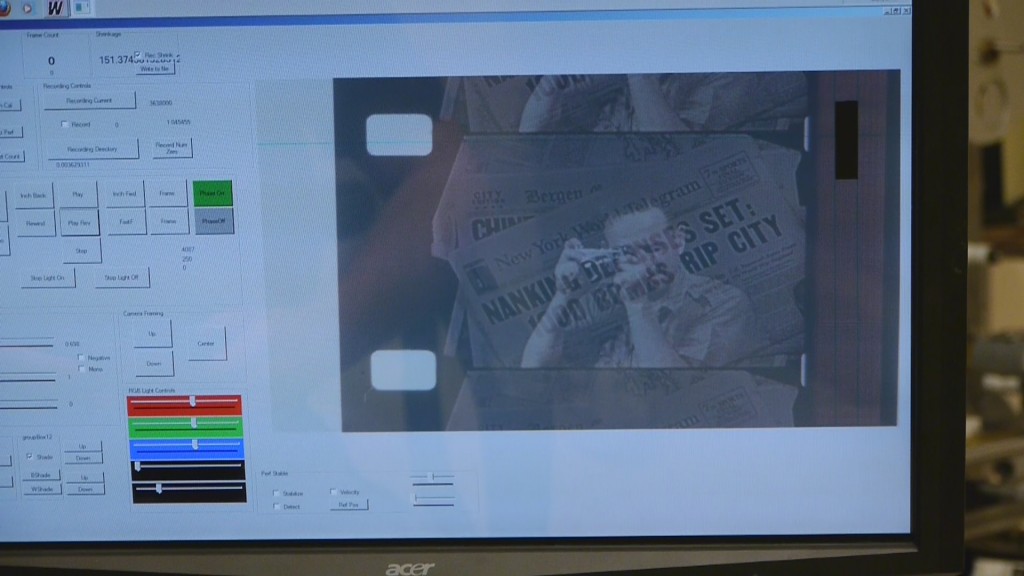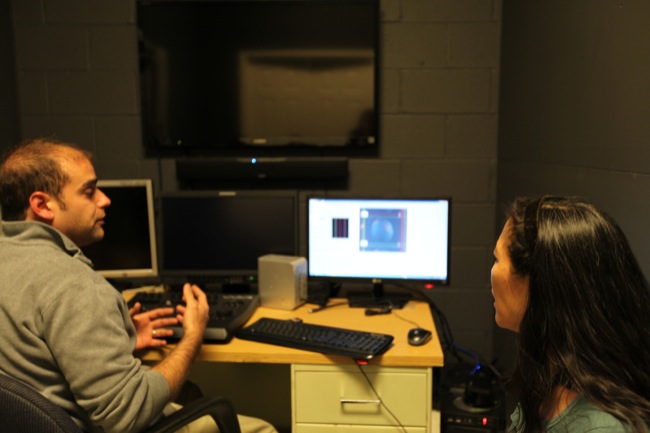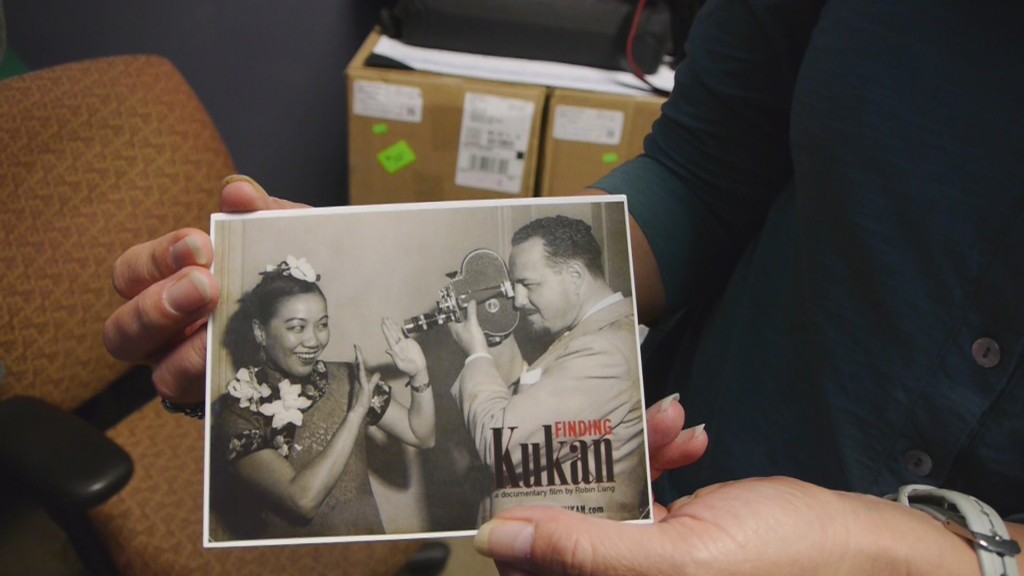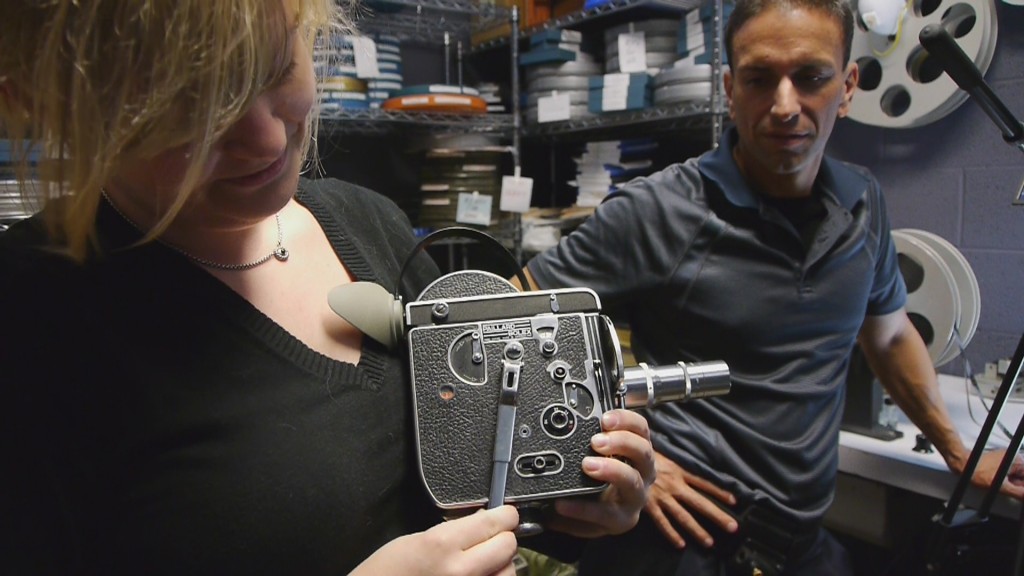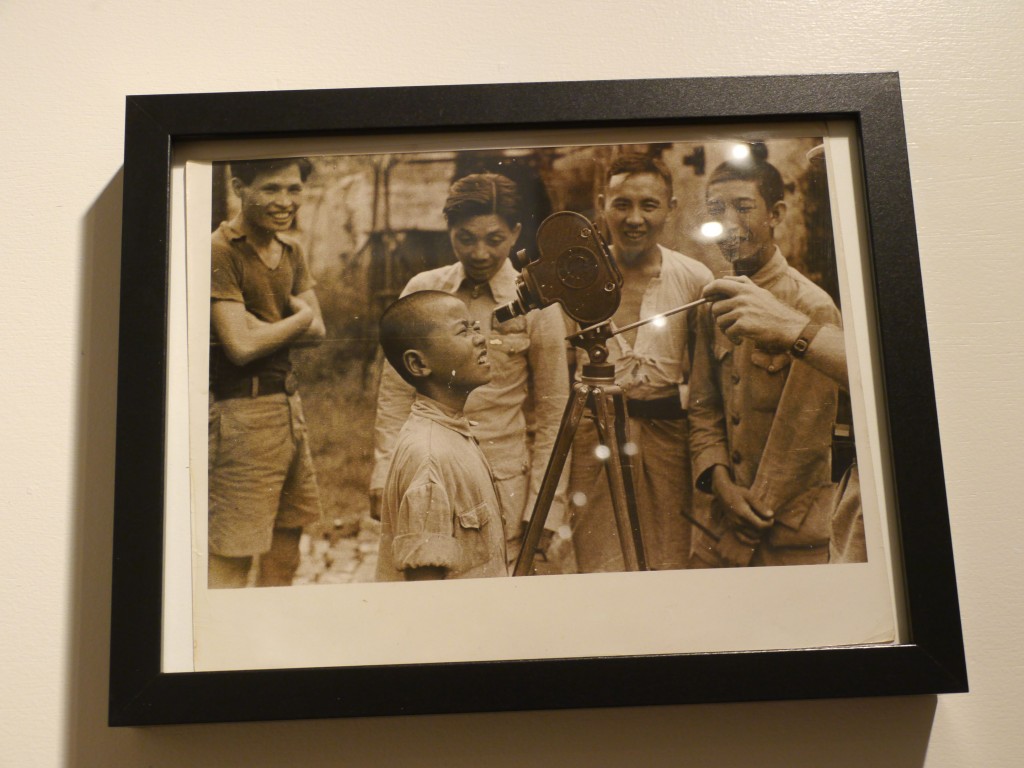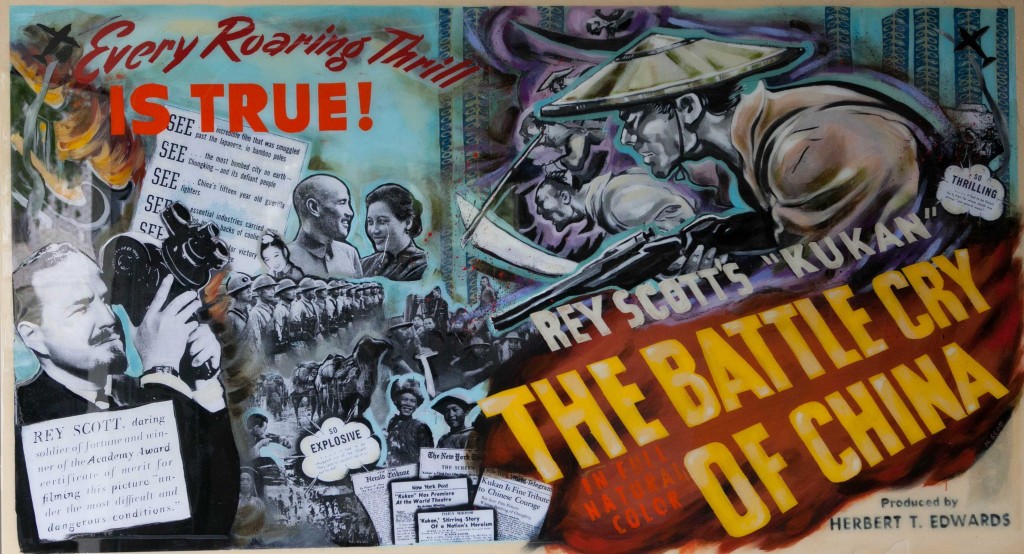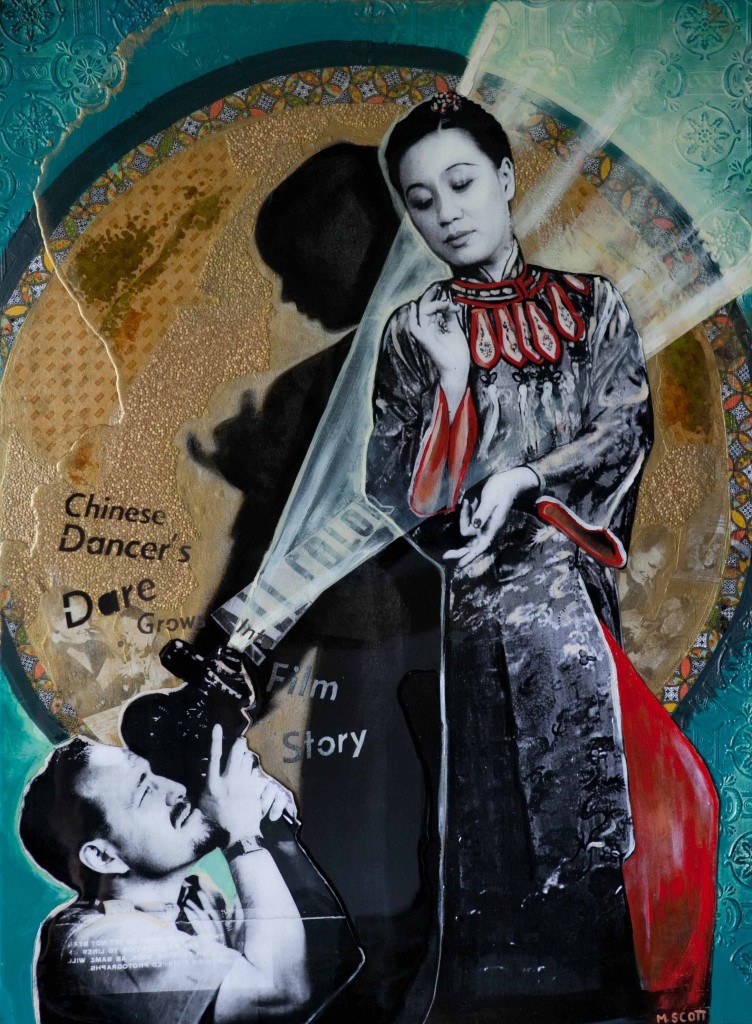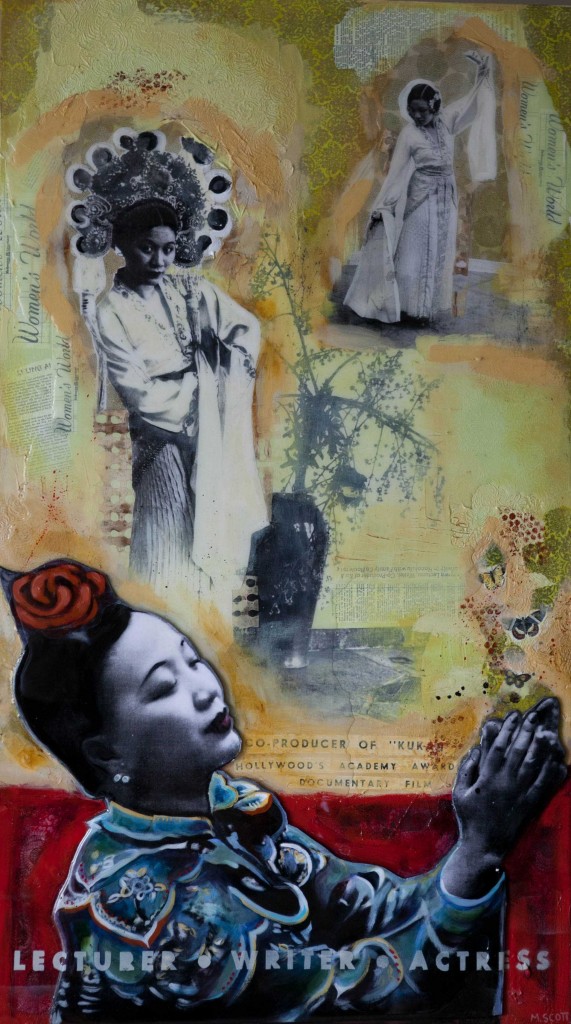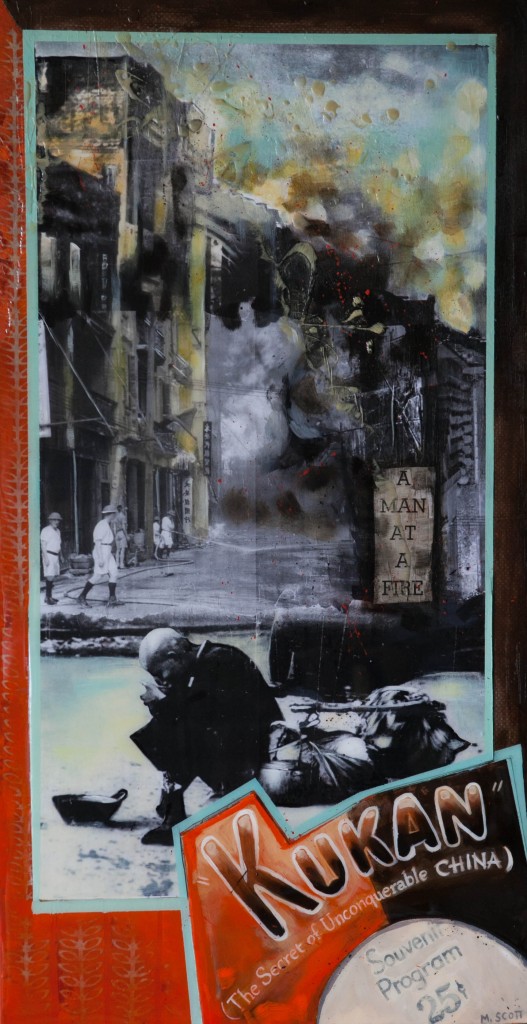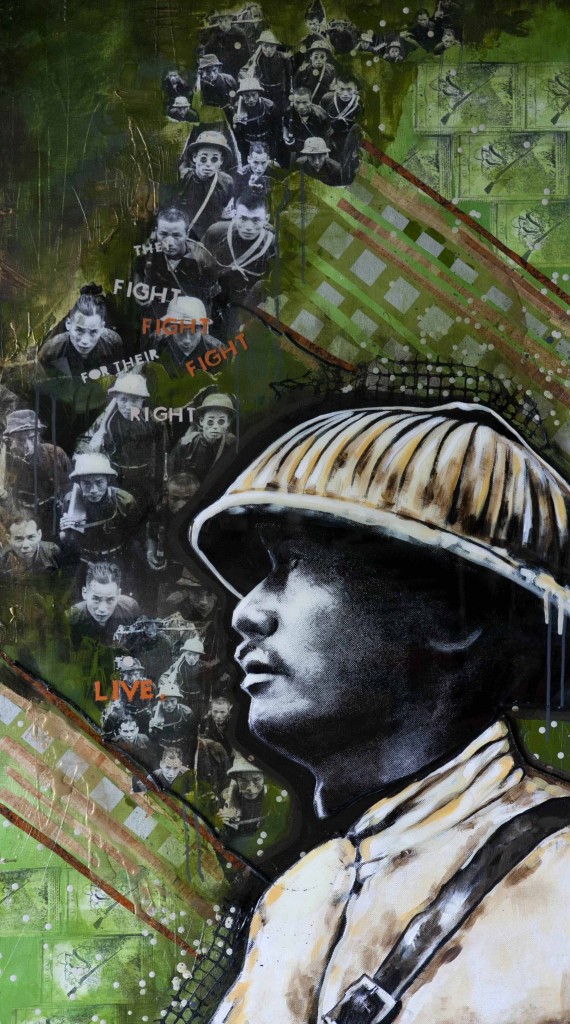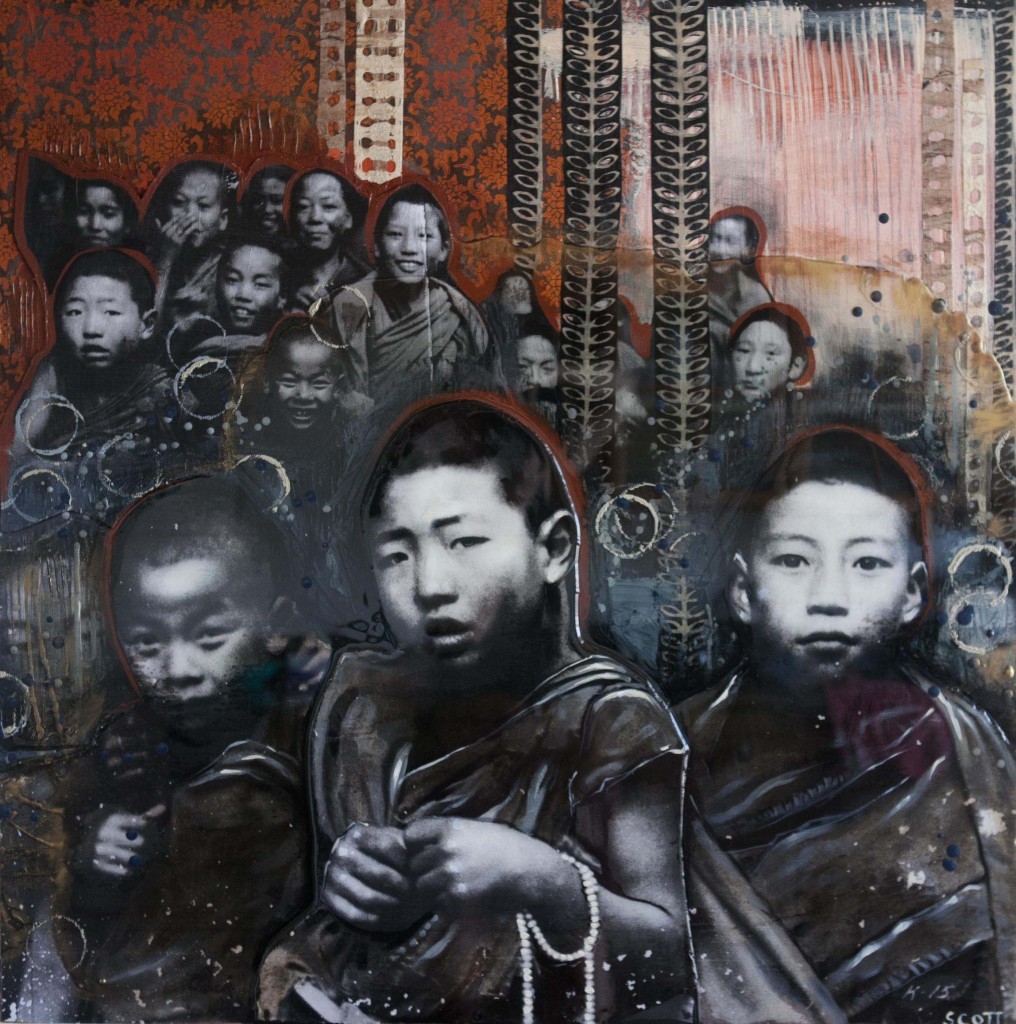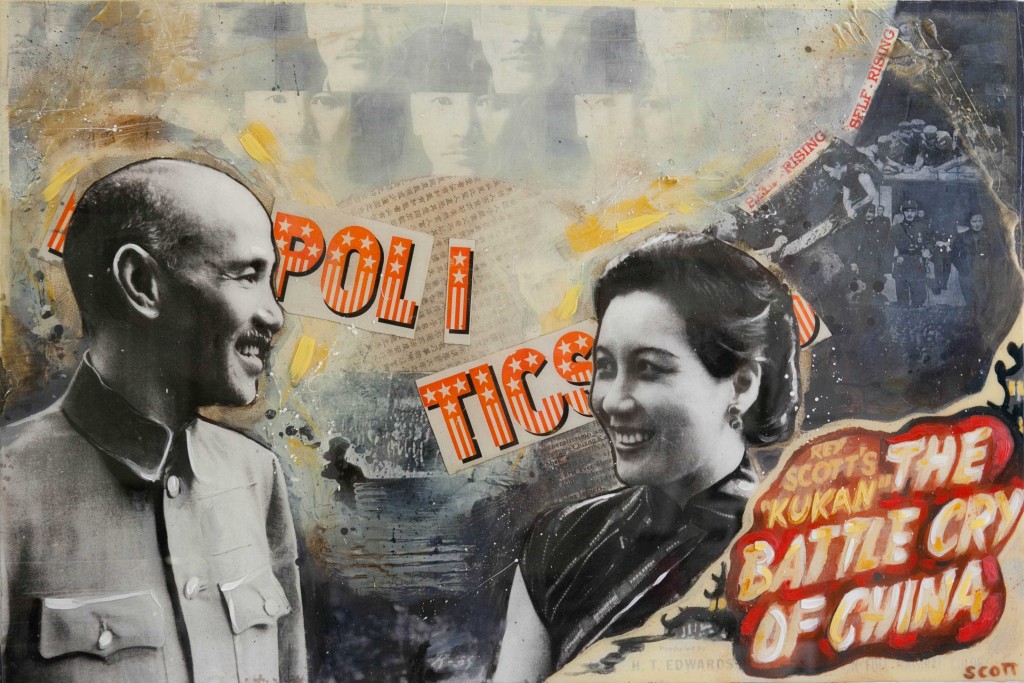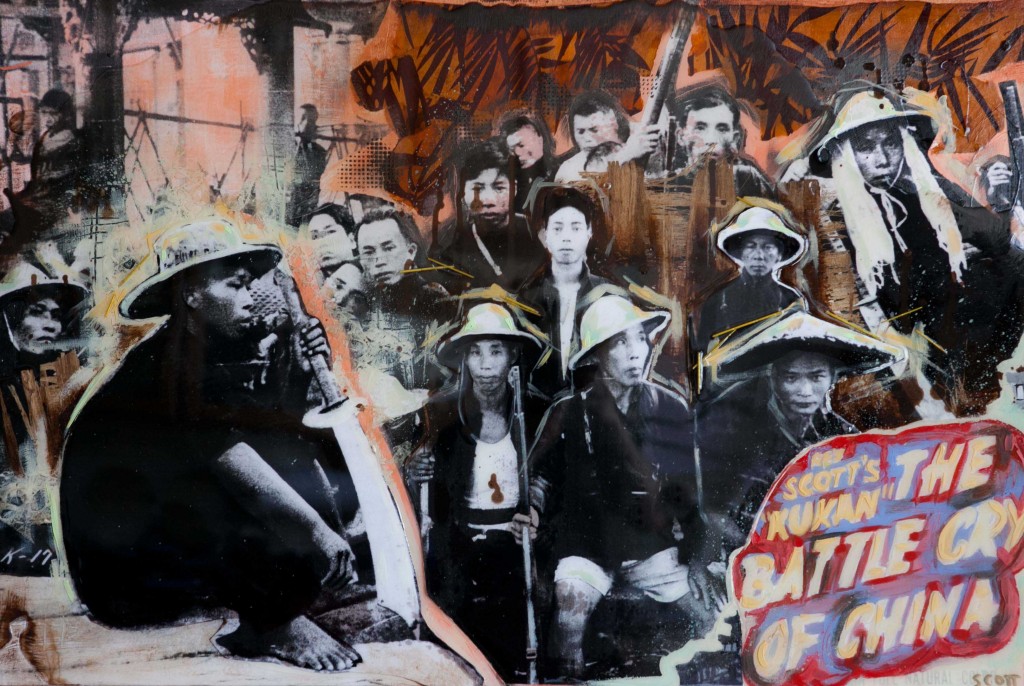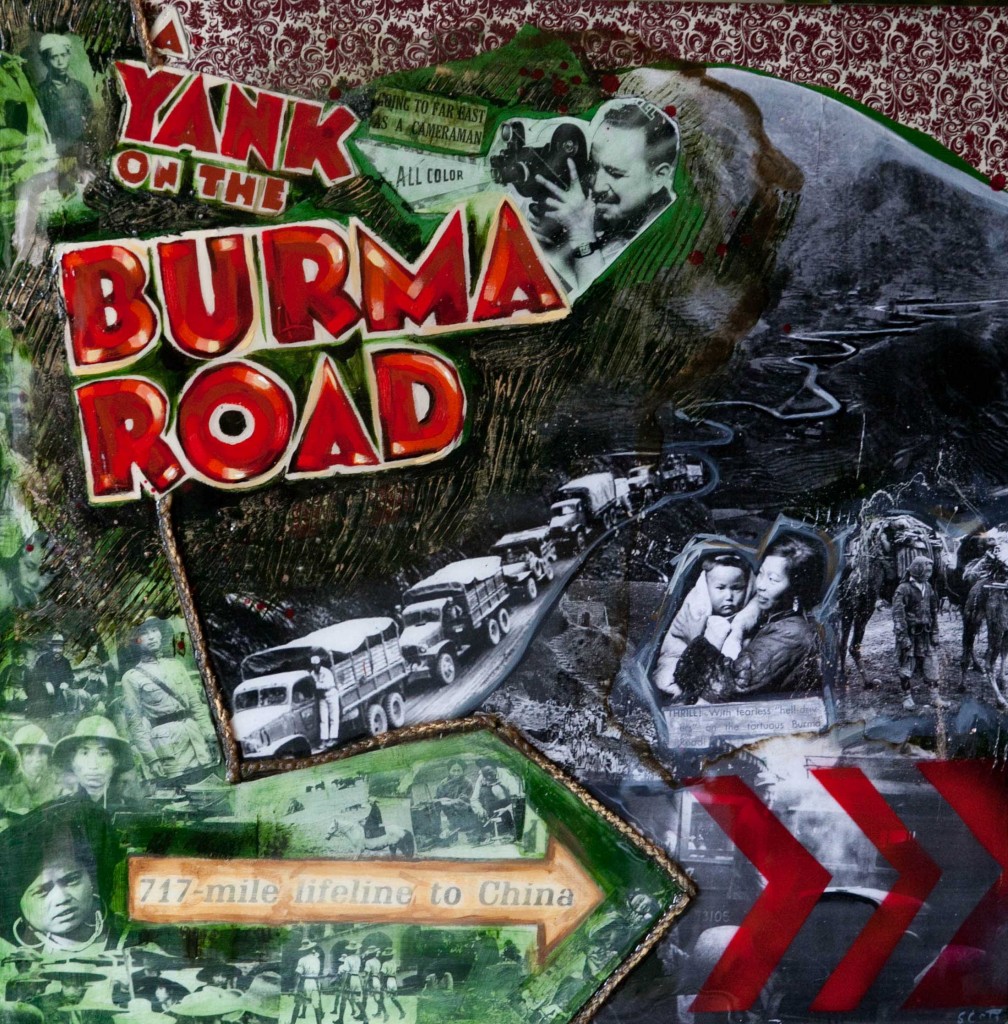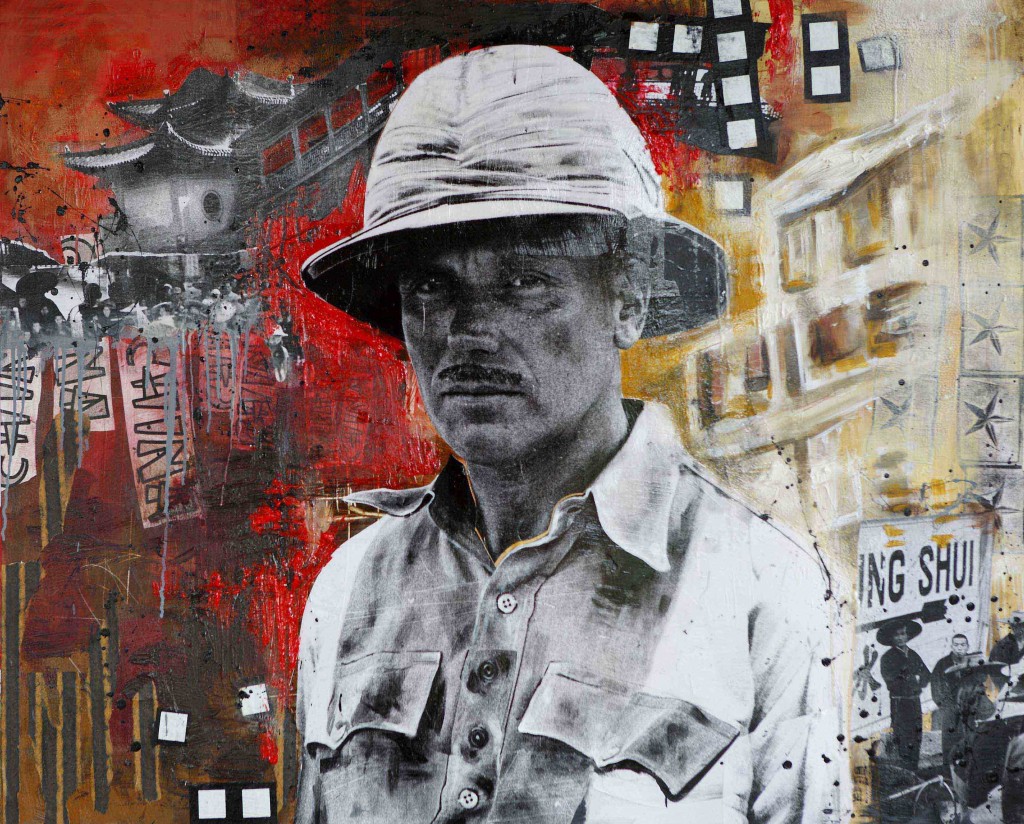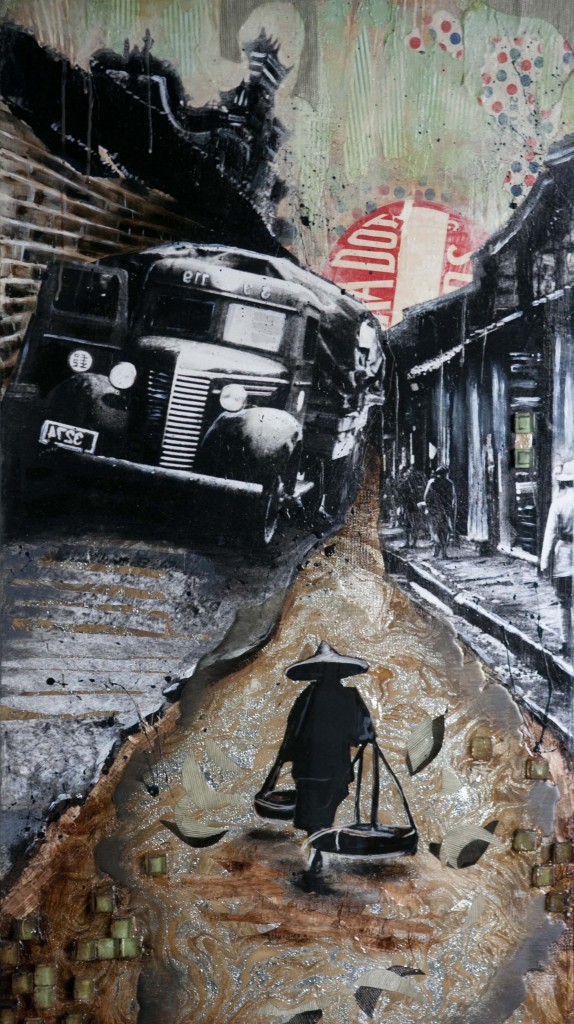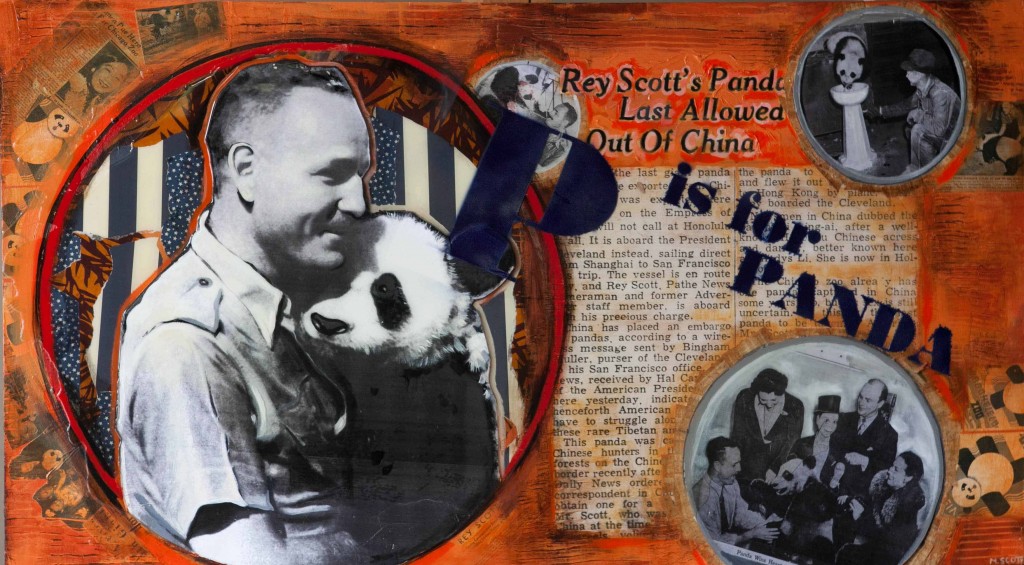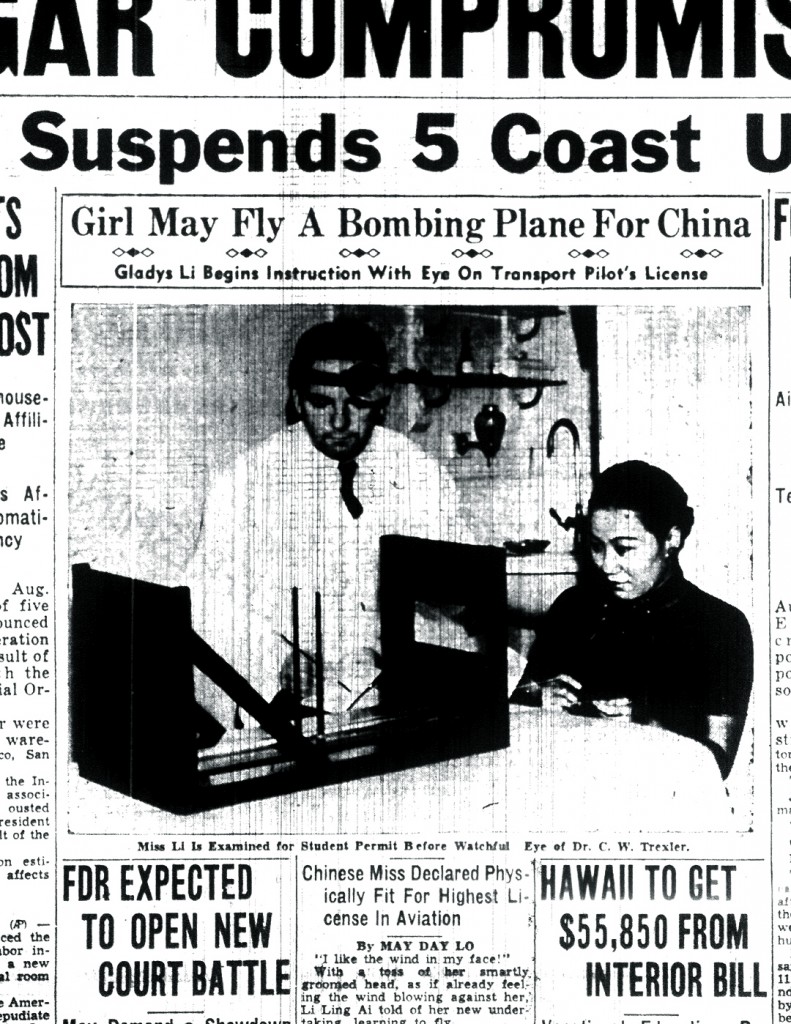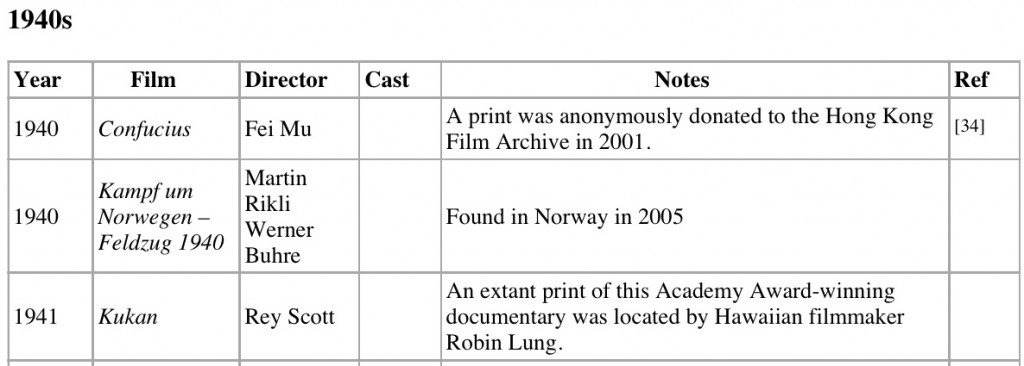Upcoming Screenings:
no event
Follow us on Facebook
HELP BRING FINDING KUKAN TO CLASSROOMS
Sign up for our mailing list.
Tag Archives: Rey Scott
The Power of the Press: Part 1– May Day Lo
A blog in support of FINDING KUKAN’s 10K in 10weeks “Keep This Film Alive Campaign”.
In the Lily Wu detective novels by Juanita Sheridan one of the colorful sidekicks is a female reporter named Steve (Stephanie Dugan) who funnels information to her two amateur detective friends Lily and Janice. Since many of her fictional characters are based on real life people, I wondered if Sheridan based Steve on some of the ballsy female reporters who were breaking into newsrooms in the 1930s. So my ears pricked when I heard that Li Ling-Ai had a journalist friend in the 30s and 40s named May Day Lo. Yes, that is her real name, and no she was not even born in May.
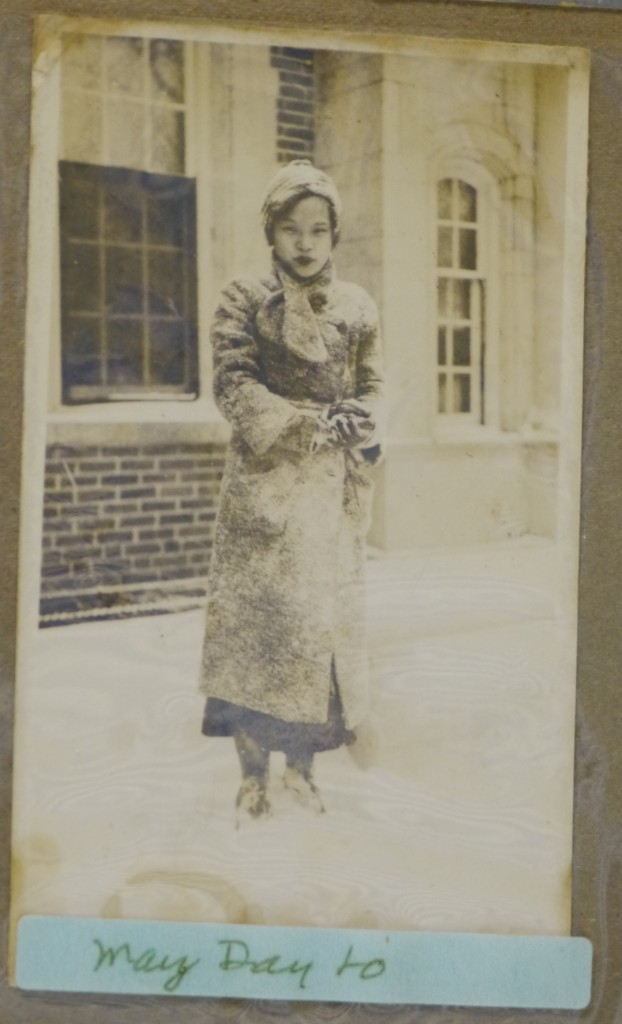
May Day Lo at the University of Missouri (photo courtesy Susan Cummings)
In the mid 1930s May Day Lo made history by being one of the first Asian American women hired to report for a major daily newspaper. The progressive Honolulu Star-Bulletin hired Lo and Ah Jook Ku after they graduated from the University of Missouri Journalism School. May Day Lo also broke ground at Journalism School by being the first “exchange student” accepted there (remember, Hawaii was still a territory and not officially part of the United States).
Notably, in 2010 when the Asian American Journalists Association put together a list of pioneering Asian journalists, a majority of them were from Hawaii. AAJA historian Chris Chow commented, “Hawaii was more open to multiculturalism. There was recognition that this is an important market and you’d better well serve them (Asian-Americans) if you want to make any money.”
Back in the 30’s, the Star Bulletin seemed to cover stories about local Asians more comprehensively than the rival Honolulu Advertiser. And May Day Lo’s byline was on several early articles written about Li Ling-Ai, including the one that probably prompted Advertiser reporter Rey Scott to call Li Ling-Ai into his office for an interview on that fateful night in 1937 when plans for making KUKAN were first hatched.
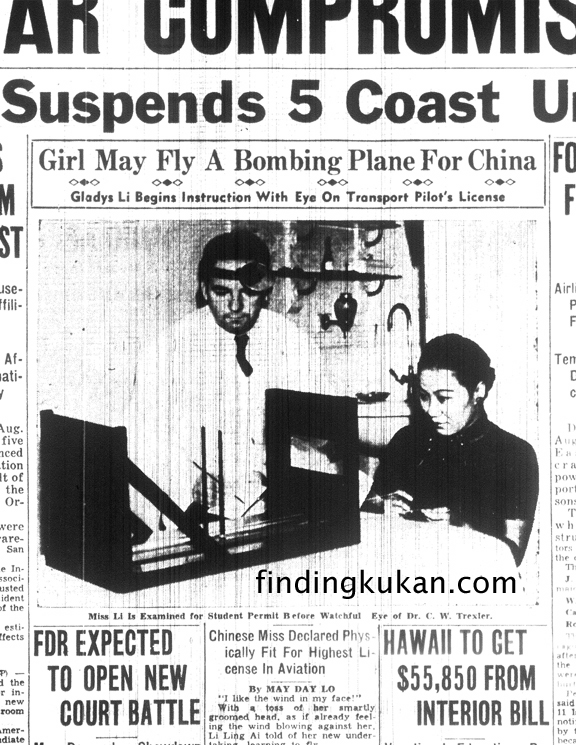
Reporter May Day Lo gives front page coverage to fellow Chinese American pioneer — Li Ling-Ai (aka Gladys Li)
I love knowing that a petite Chinese woman who was raised by a reverend in Hilo was the first exchange student at the prestigious University of Missouri School of Journalism and that the power of her pen brought attention to another pioneering Chinese young woman in a way that changed her life forever. I wanted to find out more about May Day Lo, especially when I found an intriguing letter from her to Li Ling-Ai:
July 31, 1941,
Dear Li Ling Ai,
Now that I am home again, it all seems like a dream that I met you and all the others in New York and had such a wonderful time…. Please give my Aloha to Mrs. James Young, Rey Scott and Mr. Ripley when you see them.
May Day Lo had been in New York right around the time when KUKAN premiered at the World Theater just off Broadway! She had met both Rey Scott and Robert Ripley – two key players in Li Ling-Ai’s life at the time. Could May Day hold clues to some of the unsolved mysteries surrounding KUKAN?
Unfortunately May Day had died in a tragic car accident in 1986. May Lee Chung, editor of the ACUW publication that documents so many pioneering Chinese women’s lives (see other posts about this “Orange Bible”), could remember clearly the circumstances of May Day’s death. But she did not know what had become of May Day’s only child David, someone who might be able to tell me more. The trail remained cold until the Power of the Press struck again in 2011. Stay tuned…
Support our 10K in 10 Weeks campaign by clicking the red button. 
(As of 9/6/13 we have raised $5,025 and have $4,975 more to raise by 10/15/13)
April 25, 2013 — Major Archival Discovery Starts with a Party
It was my husband Paul who convinced me that I should have a fundraising party. So last October I got many volunteers together to throw one. Terry Lehman Olival helped by sending press releases to the local media and got the attention of Star-Advertiser reporter Mike Gordon.
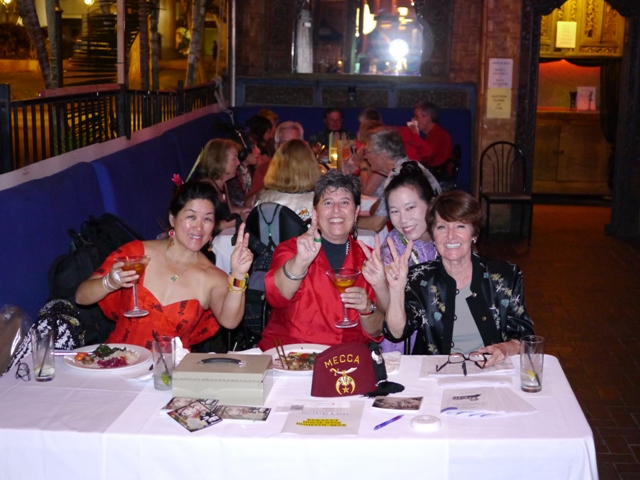
Mellanie Lee, Debra Zeleznick, Robin Lung and Terry Olival at “A Night in Old Shanghai” fundraiser
“That might be the coolest story I’ve heard in a long time,” Mike said, and promised to write an article on it. The more Mike found out, the more he wanted to know. His article grew and grew. My fundraising party came and went; my Kickstarter campaign came and went.
Finally the opus turned up – a 3‑page spread on the film, complete with color pictures, showed up in the Sunday newspaper and drew response from people as far away as Kentucky!
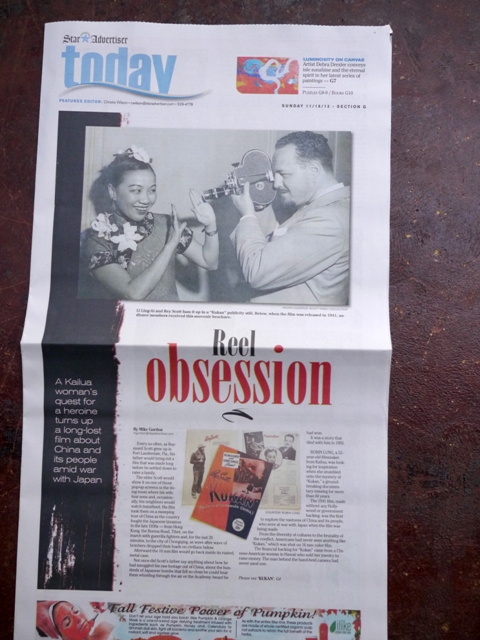
Mike Gordon’s article “Reel Obsession” appears in the November 18, 2012 Honolulu Star-Advertiser
DeSoto Brown, curator at the Bishop Museum, also read Mike’s article and something clicked. He remembered a donation of lantern slides made to the museum by Betty Li, Li Ling-Ai’s older physician sister, back in the 80’s. In fact the slides were marked as being related to KUKAN! Early in my research I had read that KUKAN’s director Rey Scott lectured with a group of slides, but no one in his family remembered seeing them or hearing anything about them. I had given up on finding them.
So I was on pins and needles last week when I finally connected with DeSoto at the Bishop Museum and had a chance to examine the slides myself. They didn’t disappoint — 97 images of 1937 Nanking, including some with Rey and Betty Li, brought Rey’s first trip to China to life for me in a thrilling way and helped answer some of the mysteries that had been plaguing me for years.
October 8, 2012 — KUKAN Moves from the ER to the Operating Table
Many of you know by now that my documentary FINDING KUKAN revolves around my discovery of the “lost” 1941 Oscar-winning color film of war-torn China called KUKAN. Many of you might also be wondering, where in the H… is KUKAN? If it was found, then why can’t we see it? Well when I tracked down the only full copy of the film it had been sitting in a Fort Lauderdale studio for a few decades and then a Georgia basement for a couple more. Heat and humidity had done its work.
When AMPAS’s Ed Carter and Joe Lindner opened the rusty metal can that contained KUKAN they winced. “Vinegar,” they both said, wrinkling their noses. I learned later that that is a sure sign of deterioration. As Joe examined the 2 reels of film that represented 90-minutes of invaluable color footage of China in 1939 and 1940, he detected both shrinkage and brittleness (more bad signs of deterioration). Joe said he’d seen films worse off…but not many. Things looked pretty grim. If we were in the Emergency Room, this would be time for triage.
Fortunately a deteriorating film takes longer to die than a bleeding human. Two years later, KUKAN has been stabilized but is still in pretty bad shape as you can see by the photos I took of it last week at Colorlab in Maryland where AMPAS sent it to have major restoration work done.
Parts of it are so curled that they will never be able to be re-plasticized (a sort of Botox process for film that hydrates it enough to allow it to lay flat in the scanner without breaking).
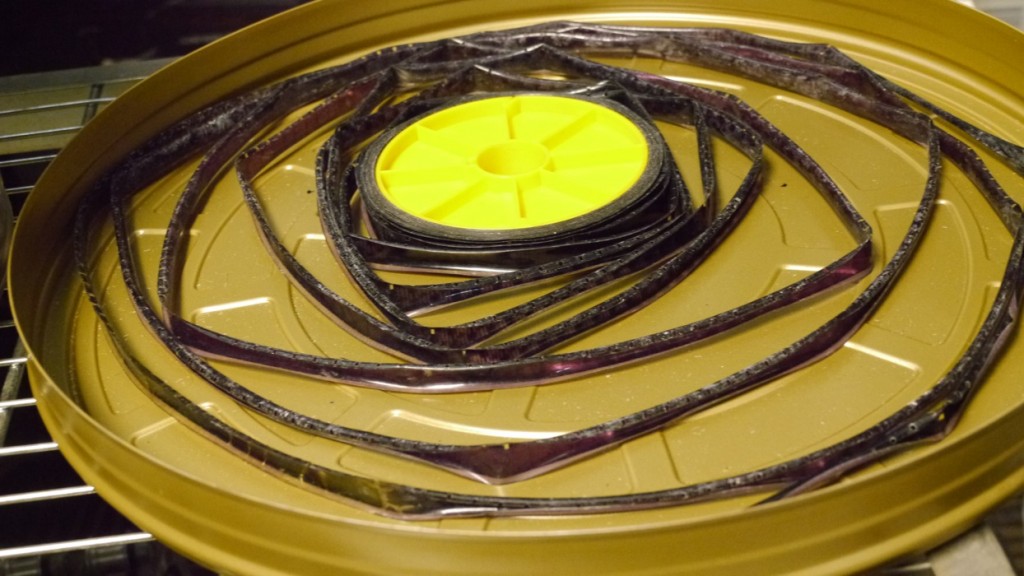
The worst part of the 2 KUKAN reels was so curled it looked like the plastic straws you drink out of.
A partial copy of KUKAN that I located in the National Archives (NARA) will be used to fill in those parts that are unsalvageable. The NARA copy was kept in a temperature controlled environment all these years and is in fairly good shape. But even that has to go through a frame by frame scanning process to pull both image and soundtrack from the 16mm strip.
DP Frank Ayala, 2nd Camera Mia Fernandez and I arrived at Colorlab to film the initial frame by frame scanning of the NARA print and learned a lot about the care and effort needed to bring a film back to life.
A.J. Rohner, head “surgeon” on the KUKAN restoration process, assured me that “my patient” could be saved despite its horrific appearance. He gave us a tour of the monster machine that does the scanning – an invention of Colorlab engineer Tommy Aschenbach.
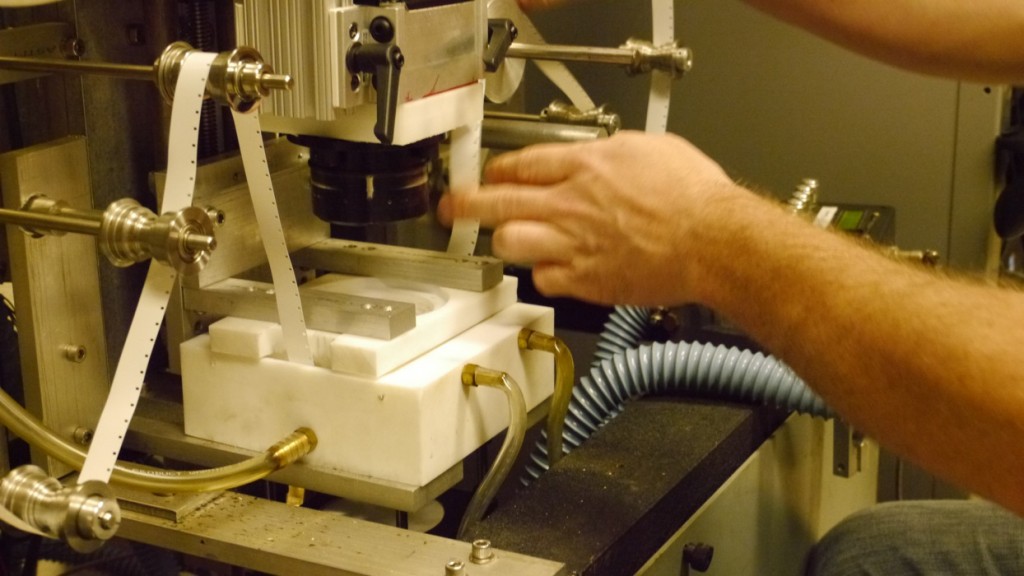
The scanner doing all the work is a fascinating contraption that blinks and whirs and beeps — just like something out of Startrek.
I was entranced by its gorgeous parts, blinking lights and robotic movements — so much more tangibly satisfying to see at work than watching the little gray line creep across your computer screen as your digital footage downloads.
I also learned how the sound from the film will be lifted from the scan, VISUALLY corrected before turning into sound waves and then cleaned and scrubbed to get all the ticks, and hisses out. I was surprised to learn that those little horizontal lines on the edge of the film are what make the sound come alive through the projector – a magical phenomenon when you think about it.
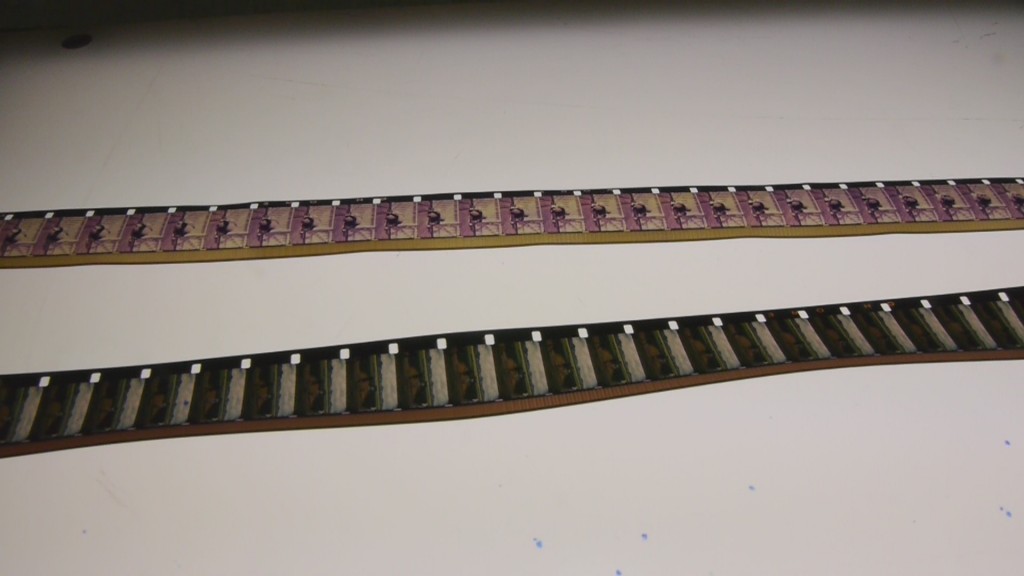
If you look carefully you can see the sound stripes on one edge of the film. The top strip is the badly deteriorated copy of KUKAN I found. Notice the color loss.
From the photo below A.J. identified the camera Rey Scott was using in China as a 16mm Bolex.
Colorlab technician Laura Major just happened to have one in the office that she still shoots with.
Holding that camera in my hands, looking through the tiny viewfinder, and learning that the camera could only shoot 100 ft of film at a time (roughly 2 minutes) gave me a much greater appreciation for Rey Scott’s heroic accomplishment in filming the epic scenes contained in KUKAN, especially the 15-minute sequence at the end of the movie that depicts the massive bombing of Chungking and the fiery destruction of the city.
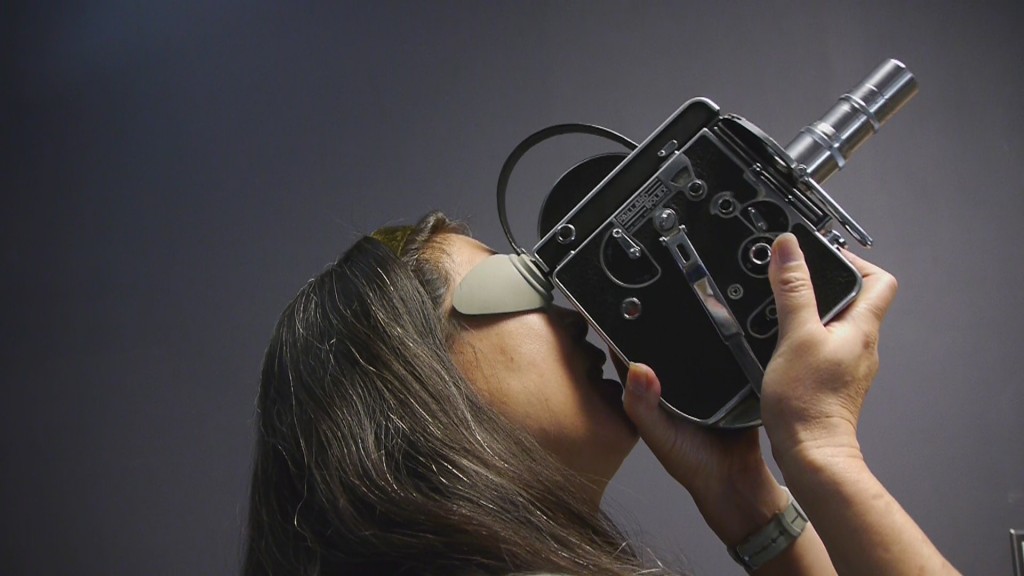
You can’t believe how tiny everything looks through this viewfinder — no wonder Rey had a hard time focusing in places.
I am more determined than ever to reach our $16,000 Kickstarter goal so that we can keep following the magical resuscitation of KUKAN and track the amazing story behind its creation. Please join me on this journey, it’s going to be an incredible ride!
October 3, 2012 — Michelle Scott Delivers a Knock Out with her KUKAN SERIES
When I first made contact with Rey Scott’s granddaughter Michelle Scott and filled her in a little about the story behind KUKAN, she felt a need to transfer that story into paint and shared with me a vision she had for creating a whole room of paintings dedicated to her grandfather and KUKAN. It seemed like a far-fetched dream back then. So I was more than a little excited to go to Atlanta to witness the opening of Michelle’s solo show — THE KUKAN SERIES. Michelle hadn’t shared any images of the new work with me, so I wasn’t prepared for the visual sweep and emotional power of the work. It literally brought me to tears. Here are a few choice pieces from the show. WARNING — these photos do not do the pieces justice. The real pieces have an almost three-dimensional quality that allows the viewer to enter into the scene and experience a little of Rey Scott and Li Ling-Ai’s world back in the late 30’s.
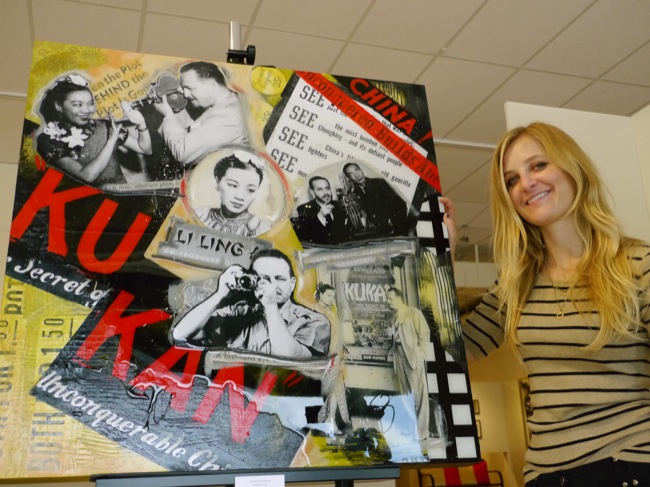
Artist Michelle Scott with “Start of a Journey” the exclusive premium available for a $5,000 Kickstarter pledge (partially tax deductible).
The 36“X36” piece that Michelle created exclusively for our Kickstarter fundraising drive is displayed right in the front window of 2Rules Fine Art in Marietta. Casual strollers walking down the sidewalk can’t help but be pulled in to find out with the imagery is all about. For close up details of this painting go to our Kickstarter home page.
The KUKAN Series contains a few gorgeous tributes to Li Ling-Ai the Chinese American author who was the uncredited co-producer of KUKAN with Rey Scott.
The work below contains images of Li Ling-Ai from three different decades and three different locations (the old Honolulu Academy of Art, Beijing China, and New York City)
There are also fabulous pieces that provide a visual montage of the China witnessed through Rey Scott’s camera. He took both stills and 16mm color movies. Some of his old cameras are on display too with the original stills.
Rey Scott traveled all the way to Tibet and filmed some of the first color footage of prayer rituals there.
Michelle’s take on the original KUKAN lobby cards for the United Artists version of the film.
Rey Scott also filmed the famous Burma Road as it was being built.
A reminder of the British influence in Hong Kong which fell to the Japanese in 1941.
A whole movie could be made just about the baby giant panda bear that Rey Scott brought from Chengtu to the Chicago Zoo. Originally christened “Li Ling-Ai” by the foreing journalists in Chungking, it was later named Mei Lan when it was identified as a boy panda bear.
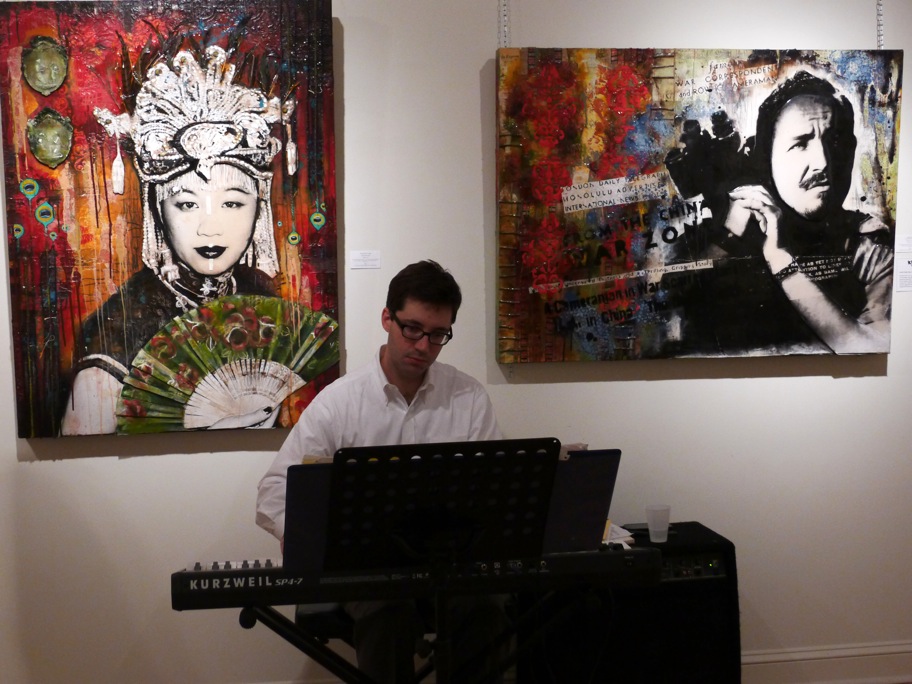
“Portrait of a Lady” and “For Him” are the first two pieces that Michelle Scott made in the KUKAN Series
There are many more gems in this show. But the emotional highlight for me was being able to see the first two portraits of Rey Scott and Li Ling-Ai that Michelle did. I first saw them on her website before we even knew each other and before she even knew who Ling-Ai was. This was the first time I was able to see them both in person. Since the pieces had been sold to different collectors several years ago, this was also the first time they were reunited in the same room for quite some time — a symbol of hope for me as I continue to seek funding to finish FINDING KUKAN.
If you are in the Atlanta area make an effort to see this historic show — up only until October 26, 2012
August 10, 2012 — Li Ling-Ai 75 Years Ago
When I was invited recently to participate in a conference to commemorate the 75th anniversary of the Nanking Massacre this coming December, I realized that the film KUKAN also celebrates a whole string of 75th year anniversaries. Today happens to be the day that Li Ling-Ai (aka Gladys Li) appeared on the front page of the Honolulu Star Bulletin newspaper, lauded for her desire to fly a plane to support China’s resistance to Japanese invasion.
A month before this Amelia Earhart’s plane disappeared. It’s a reminder that in 1937 airplane flight was still relatively new and few women were undertaking the risky hobby.
Flying a plane is just one of the pioneering feats of Li Ling-Ai and what brought her to the attention of the Advertiser reporter Rey Scott who would eventualy become her filmmaking partner on Kukan.
Also noteworthy is that the author of the Star Bulletin article, May Day Lo, was one of the first Asian American female reporters on a major city newspaper.
Have any other 75th anniversaries to share? Feel free to comment.
February 19, 2012 — What do HUGO and FINDING KUKAN have in common?
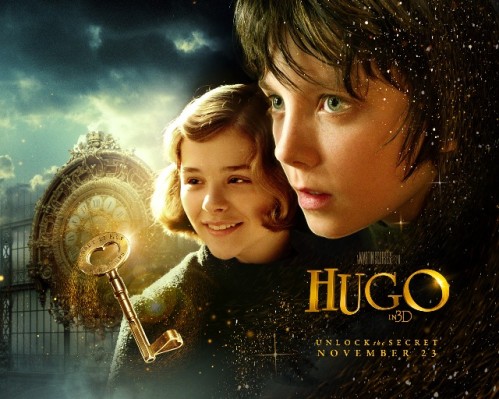
Martin Scorce’s HUGO is a tribute to film pioneer Georges Melies
Like many people who were charmed by Scorcese’s recent film HUGO, I had little knowledge of early film history or Georges Melies before seeing the movie, so I headed to the internet afterwards to find out a little more about him.
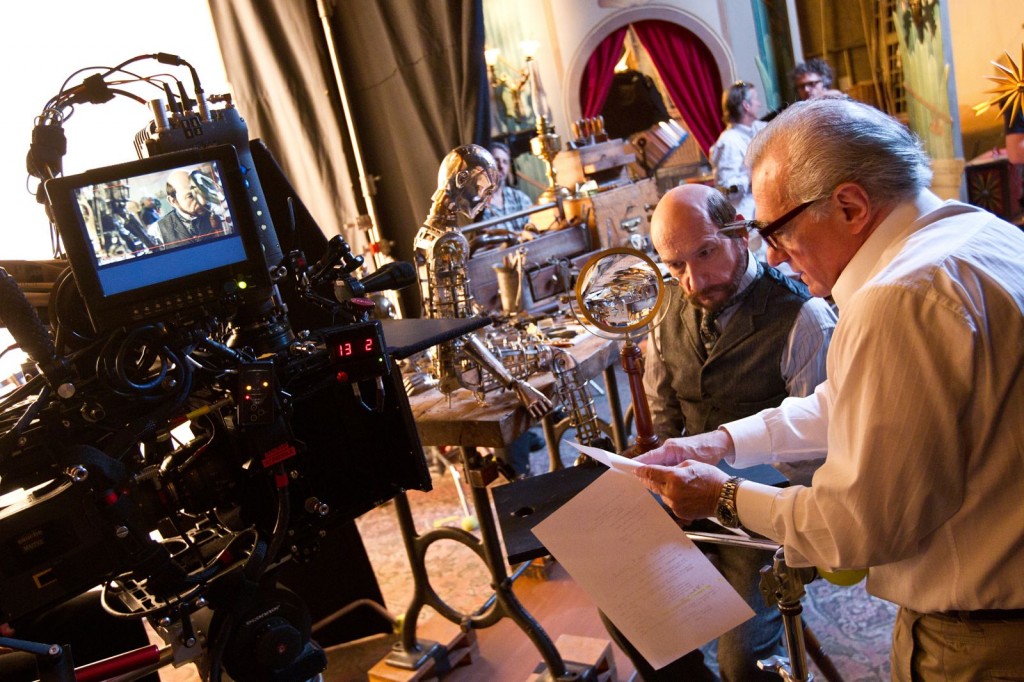
Ben Kingsley (center right, as Georges Melies) confers with director/producer Martin Scorsese (far right) on the set of HUGO, from Paramount Pictures and GK Films. Photo: Jaap Buitendijk.
Although Melies is recognized today as an early film innovator with a fabulous imagination, he fell out of favor during his lifetime and many of his films were melted down or destroyed.
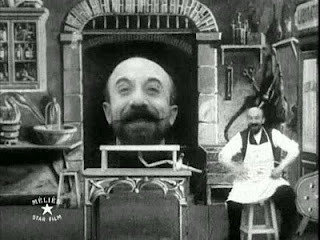
Still from Melies’s THE MAN WITH THE RUBBER HEAD
While reading about Melies, I ran across Wikipedia’s list of Rediscovered Films. Happily a couple of Melies’s films from the 1890s have been rediscovered in this century.
Scrolling down the list, look what film shows up in the 1940’s … Rey Scott’s KUKAN!
And that’s the answer to a film trivia question that might someday be asked on a game show in the far future – HUGO and FINDING KUKAN are both about rediscovering lost films and forgotten filmmakers.
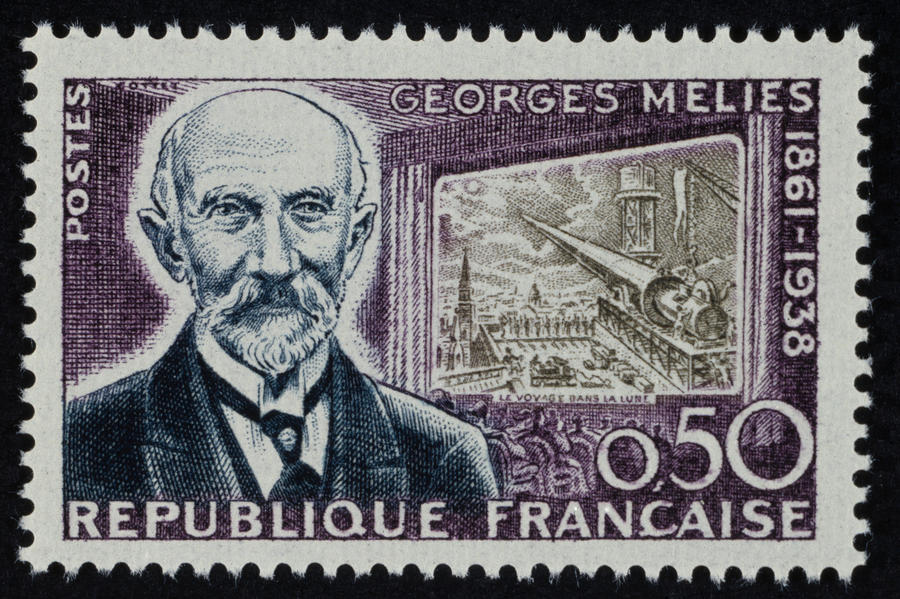
In 1961 the French government issued a postage stamp in honor of Georges Melies’s cinematic contributions.
Maybe someday KUKAN, Rey Scott, and Li Ling-Ai will have a postage stamp dedicated to them too.
December 1 to 31, 2011 — Producer/Director Robin Lung Featured on Career Changers TV
Although I’m more comfortable being behind the camera than in front of it, I agreed to be profiled on OC 16’s Career Changers TV show in order to get the word out about FINDING KUKAN. Producer Rich Figel and Cameraman/Editor Stan Chang managed to boil my life of job-hopping down to a succinct 4 minutes or so. Even better, the lead in and out of the piece made people really want to see the work-in-progress trailer and learn more about KUKAN. The show airs through December on digital channel 16 or 1016 in Hawaii. The show is rebroadcast Fri 2:30pm, Sat 6:30pm, Sun 12:30am, Mon 9:00am, and Wed 2pm and Thur 8:30pm through December. If you can’t catch it, here is a low resolution version.
You can see the nice lead up to the trailer here. And a fabulous article Rich wrote about “The Mystery of Li Ling-Ai” here.
December 2, 2011 — Gifts From the Blogosphere
There’s nothing like having a cold over the holidays to make you feel sorry for yourself. It’s that old dejected feeling that creeps in as the box of kleenex gets emptied. Now that I’ve recovered, I’m having some belated Thanksgiving thoughts, tallying up the windfalls that have come my way over the past year — many by way of the internet and blogosphere. Recently I made an internet connection with blogger Durian Dave, who turned out to be a very generous like-minded soul with an incredible visual archive and wealth of knowledge about old Chinese films and film actresses. See his blog and Tumblr for hours of entertaining and eye-opening articles and photos. David advanced my KUKAN research tremendously by sending a bunch of choice KUKAN related items to me, including this vintage lobby card.
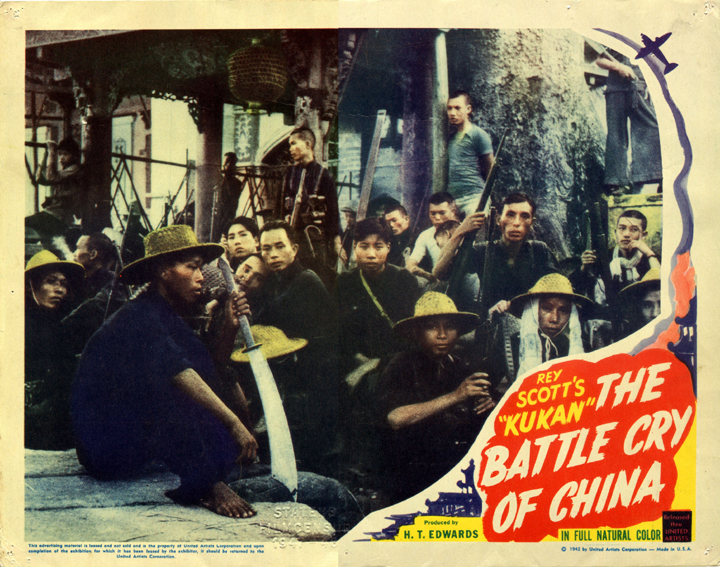
Lobby card for the 1941 Oscar-winning documentary KUKAN
Besides displaying gorgeous color and imagery, the card had an intriguing embossed stamp on the bottom of it: “STATENS FILMCENSUR 1947–48.” David suspects that the stamp refers to Sweden’s censorship board. If he’s right, that means KUKAN screened all the way in Sweden! So if any of you Swedish film collectors come across 16mm Kodachrome color footage of China that appears to be from 1939 or 1940, let me know! We’re still looking for good partial prints to help with the KUKAN restoration.
My next post will feature the fabulous photo of a jet-setting Li Ling-Ai that Durian Dave dug up as well as info about a couple of other groundbreaking Chinese American females working behind the camera. Why not now you might ask. Hey, I’m still recovering!
July 11–16 Road Trip to Kennesaw & Tallahassee
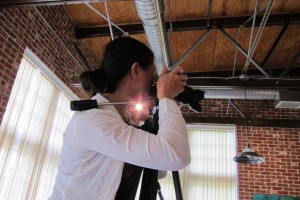
Director Robin Lung films in Georgia

Michelle Scott with a few paintings from her KUKAN series
As I packed my suitcase I worried that since Michelle and I didn’t really know each other the trip could be a total fiasco. Fortunately Michelle and the rest of the Scott family were so openhearted and supportive that I felt instantly comfortable after meeting them and the trip was more successful than I could have imagined. Witnessing Michelle’s passion for her art and her commitment to preserving her grandfather’s legacy infused me with new energy to face all of the tedious things that go along with documentary filmmaking (like logging and transcribing footage and writing grant proposals).

Ray Scott relaxes before interview.
I realize that gaining access to people and places outside of my everyday comfort zone is one of the immeasurable rewards of this process. I’m looking forward to what the next road trip will bring me.

Mark Scott and Michelle Scott examine Rey Scott’s cameras as cameraman Kevin Deyo films the scene.

